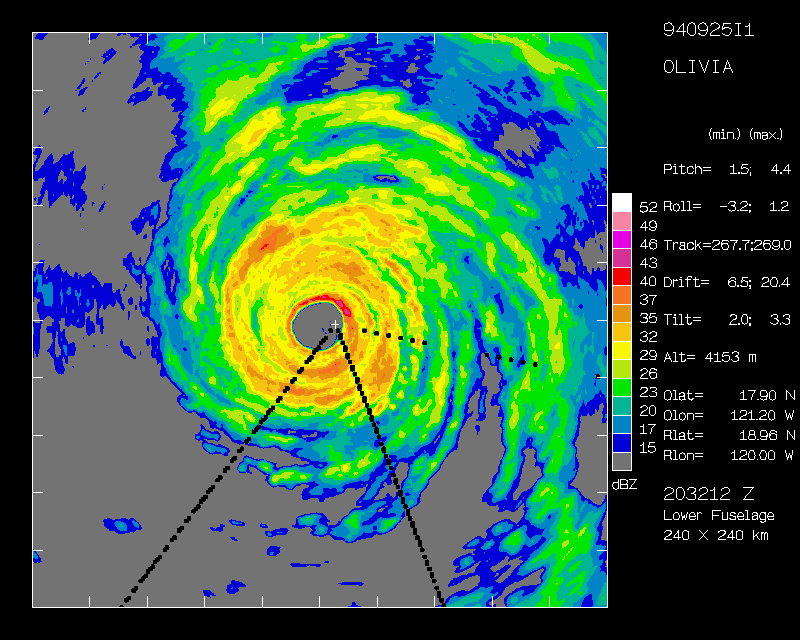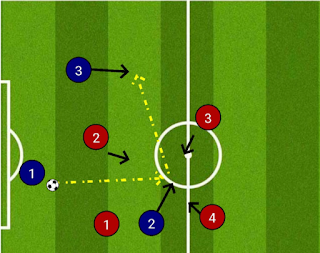Introducing the 3-2-3-2
3-2-3-2
The 3-2-3-2 is a formation used exclusively in youth soccer and yields fantastic results. One soccer coach I know knew little about soccer, but his teams won state championships year after year. His teams used this formation to beat teams with far better skill at all positions.As you can see, the 3-2-3-2 has a ton of advantages:
1. Maximum number of passing options with triangles and diamonds all over the field
2. More lines (4 instead of 3). This means:
3. Shorter range passes, and
4. Less distance to run in transition
5. Strong central position -- it's like having 3 center midfielders
6. Defend with 5 players
7. Transition with 5 players
8. Attack with 5 players
9. Midfielders line up naturally in coverage gaps of common formations.
Just take a look at all these short passing options!
It has only two obvious drawbacks.
1. 3-2-3-2 is a narrow formation. It can be beat with a wide attack using long crosses.
However, most kids at this age can't play the ball all the way the across the field, so the 3-2-3-2's biggest weakness can't be exploited.
2. The 3 defensive back set can't cover 2 strikers and outside runs at the same time. (Of course, we have a fix for this--read on.)
In professional leagues, the extension to this formation is the 3-5-2, which is used, in fact, to create a very wide attack and utilizes wingers with extraordinary fitness. So don't confuse them.
The 3-2-3-2 is optimal for young players with limited passing range and fitness, where play is practically limited by kicking distance to one third or one half of the width of the field at a time. When the basic concepts of defensive transition, inside-out passing, team shift, give-and-go, and attacking runs are mastered, this formation stops attacks, and yet wins more balls and creates more scoring opportunities than any other formation for youth soccer. The goal of soccer is to score more goals than the opponent. If scoring is a secondary objective, we can't honestly expect to win.
Why don't more coaches use the 3-2-3-2? One reason is they don't understand what it is like to be a kid. Imagine playing on a field twice or three times the size of a full-size field. Can you imagine how hard a cross is? How hard is a corner kick? How tired would you get transitioning from offense back to defense? How far do you have to pass? How useless is the player on the far side of the field. You can't even kick to him. What good is he? With a field that size, only part of the field is ever used at a time. So you don't need players in the other parts of the field. This is the idea behind the 3-2-3-2. It is optimized for small players on a big field. In this scenario, it pays to sacrifice width for more lines.
First, let's look at the more common formations and their limitations for players with short kicking range compared to the field size. We'll start with the familiar 4-3-3.
4-3-3
In this formation we defend with 4, transition with 3, and attack with 3. So we get beat on defense. Lose the ball in the midfield and attacks sputter. The outside defender has only one credible pass. The center mid is easily covered, so play goes to the sideline, where the opposing defense presses and wins the ball when the wing plays a predictable pass to the forward. This is the typical play 90% of the time for youth teams with this formation. Ideally we would defend with seven players and attack with 6 players, but the mids get too tired having to cover so much range.A common variant is the 4-3-3, where the 6 plays stopper.
We defend with 5, transition with 3 and attack with 5. This is better, but notice the lack of width in the midfield, also the lack of passing options. 8 is the only short passing option, and that can be covered. This formation is best when the 8 and 10 are stellar players who can retrieve balls, cover huge areas and beat players in the midfield. When you have two outstanding players with remarkable fitness, this is a viable approach. Otherwise the defense gets stuck with the ball.
Now consider the venerable 4-4-2.
4-4-2
Here we defend with 4, transition with 4, and attack with 2. Now ideally Players 7 and 11 participate in the attack, but in practice, they are too tired, having to cover on defense as well. This often ends up an 8-2. Defense is fine, but attacks stall at this age group due to lack of runs from the exhausted wingers. This formation demands creative movement from players and is designed to create maximum width--something players with limited kick range can't take advantage of.Lesson 1: Defending with the 3-2-3-2
The first thing to notice is that opposing strikers will line up in the gaps between the defense. This looks precarious. If one of them gets the ball the center defender can't cover both. They pass around him and score easily. The outside defenders 2 and 3 also can't cover a run from the wing midfielders or both strikers are now one-on-one. It's a striker's dream. This looks dangerous!
This is why we don't defend in a 3-2. We ONLY use this 3-2 formation when we have the ball. When the opposing team recovers the ball, three things happen.
1. The nearest defending mid puts pressure on the ball.
2. The other defending mid covers, retreating quickly to become the second center defender. Voila! Its a 4-1. We can cover both strikers and outside runs. And the ball carrier has trouble passing thanks to the stopper.
3. The wing defenders compress and entire defensive line gets very compact, inviting outside runs, which we can trap because players at this age can't cross long distances and strikers tend to move up and down the field, rather than diagonally.
This looks now like a 4-1-3-2, a more common formation, but one which will have trouble in transition. Once we recover the ball, the 5 moves up to a defending mid spot and we now have twice as many options for getting the ball out of the backfield, including dangerous options in the center of the field.
Both the US mens and women's teams are now allowing one defender to move up when their team has possession. You don't need two center backs when you have the ball! For the men, the center defender moves up. For the women, the wing defender joins the attack. This puts pressure on both the center and edges of the field. Observe, now, what happens when the first pass goes inside rather than to the wing midfielder.
Inside passing option
Here the keeper has two good outside options. 4 covers the center, while 2 and 5 position their defenders then move into the space where the ball is headed. 2 and 5 do not stand where they want to get the ball! They would be covered. So they move away from where they want the ball, then run to the open space after the kick. Notice keeper doesn't have to play all the way to 7. That's a long kick! Now, let's say 5 gets the ball. If this were a 4-4-2 or a 4-3-3, his only forward pass option is a long ball to the forwards who are unsupported. Not so with the 3-2-3-2. We have an extra line. Now watch the magic.
5 plays a give-and-go with 7. Who is guarding 5? He came out of nowhere, and yes, he is unguarded and in the middle of the field! 7 drops to cover his position. Both strikers do something strange. They both run ballside, I mean really ballside. Defenders at this age don't track lateral runs well. 11 is going to be open because 9 is stretching the defense. 10 moves into space in case both center mids track 11. He'll be the switch option. 8 makes a backside run hoping to draw a defender. 5 has so many options, and all of them dangerous. We have five players committed to the attack. It feels like we are bringing the house--every time. Here is another variant.
Same give-and-go, but the strikers both pulls their defenders wide, while 8 and 10 start their runs. They will hit the stretched back line at full speed. 5 sees the runs and plays a ball through one of the slots, or if the defenders stay compact, he has an easy ball to 9 on the sideline for a early near-side cross to 8 or 10 or the long cross to 11, if he has the leg.
What if the defense catches on and covers 7? Then the switch is on!
5 creates this play by starting wide and running back to the middle to receive the ball. Playing the way he his facing, he plays into space, where 10 meets the ball. 10 swings it to 6 who passes it wide to 8. The defense is now frantically trying to get to the far side of the field. The odds that they will track of all the runs from 7, 9, and 10 are quite low. 11 was a key player here, staying high to keep the defense back, then pulling to create space for 10's run. His little circular run was very important. 8 hits the early cross to 10, who has a long shot or pass options to 9 and 7, against the direction the defense is moving.
This isn't even half our options. Let's say 5 plays 7, but instead of giving it back to 5, he plays 9.
It's a perfect chance for a give-and-go. 9 pulls, drawing his defender with him. 7 sprints ahead to collect the one-touch pass. 10 makes a run into the space 9 created. 7 can't beat the entire defense, so he passes early to 10, who has 8 and 11 as pass options, plus a shot, plus 7 streaking down the sideline stretching the defense. 8 and 11 coordinate their runs. If 11 runs inside, 8 goes out and vice-versa. These are all short passes, but we are making the defense cover people they aren't expecting.
Short passes and overlapping runs are key to beating defenses. While we start narrow on defense, our attack is maximally wide. Every player as has plenty of drop options in case the forward pass is covered.
The Shift
This is pretty basic. I'll let the picture say most of it. We shift as a team on defense, quickly! The goal is to keep the whole team in the same third of the field as the ball. We leave the back post open because (1) people can't kick that far, (2) if it is the only pass open the we know it's coming and we will be ready to shift with the ball, and (3) people don't have a lot of time to get a cross because we are all over the ball, all the time.
Next time we'll go into detail on "the hurricane", showing how when everyone rotates, the ball ends up moving forward.
















I read this
ReplyDeleteHey, Traven and I both read this!
ReplyDelete